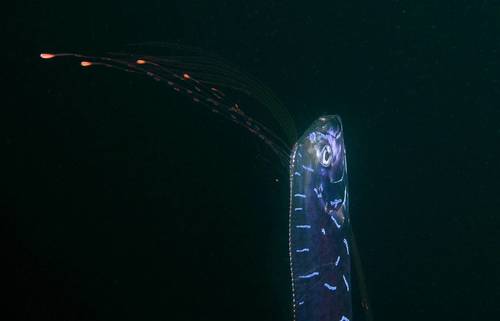
Oarfish
The Atlantic bluefin tuna (Thunnus thynnus) is a highly migratory, pelagic fish renowned for its size, speed, and commercial value. It plays a crucial role in the marine ecosystem and is a prized catch in fisheries worldwide.
Unknown Unknown years
Lifespan
800 - 1100 cm
Length
Least Concern
Conservation Status
Unknown km/h
Swimming speed
Carnivorous, Filter Feeding
Diet
Pelagic Migration
Migration
Appearance Overview
The Atlantic bluefin tuna is renowned for its impressive size and sleek, torpedo-shaped body, perfectly adapted for speed and agility in the water.
Color
Dark metallic blue on top with a silvery underside, providing camouflage from above and below.
Fins
Two dorsal fins, the first depressible, and a series of finlets running from the second dorsal and anal fins to the tail.
Body Shape
Streamlined, torpedo-shaped body designed for efficient swimming.
Length
Typically up to 10 feet (3 meters), but can reach up to 13 feet (4 meters).
Weight
Commonly up to 550 lbs (250 kg), but can reach over 1,500 lbs (680 kg).
Diet
Carnivorous, feeding on a variety of fish, squid, crustaceans, and occasionally, zooplankton and eels.
Feeding Behavior
Highly active predator that uses its speed and agility to chase down prey. They can also filter-feed for smaller organisms.
Social Behavior
Forms schools, especially when young, which can range from a few individuals to several thousand. Adults can be solitary or form smaller groups.
Commercial Relevance
Extremely high value, particularly in sushi and sashimi markets, where its fatty flesh is considered a delicacy. This high demand drives significant fishing pressure.
Conservation measures
Subject to international fishing quotas and regulations managed by organizations like ICCAT. Marine Protected Areas and seasonal closures are also used.
Status
Endangered (according to some assessments, though regional variations exist).
Threats
Overfishing is the primary threat, driven by high demand for sushi. Climate change and habitat degradation also pose risks.
Habitat Distribution
Depth Range
0-1,000 meters (typically found in the upper layers of the water column, but can dive deeper).
Geographic Range
Primarily found in the Atlantic Ocean, including the Mediterranean Sea. They undertake long migrations across the Atlantic.
Preferred Environment
Prefers temperate and subtropical waters, often found in both coastal and open ocean environments.
Reproduction and Life Cycle
Breeding Habits
Spawns in warm waters, primarily in the Mediterranean Sea and the Gulf of Mexico, during specific times of the year.
Development Stages
Eggs hatch into larvae, which develop rapidly in plankton-rich waters. Juveniles grow quickly, eventually reaching maturity.
Fecundity
Highly fecund; females can release millions of eggs (up to 30 million) per spawning season.
Maturity Age
Reaches sexual maturity at around 4-8 years, although this can vary depending on location and environmental conditions.
Faqs about Oarfish
How long do Atlantic bluefin tuna live?
Atlantic bluefin tuna can live for up to 40 years, although this is becoming less common due to fishing pressure.
How fast can Atlantic bluefin tuna swim?
They are among the fastest fish in the ocean, capable of bursts of speed up to 43 mph (70 km/h).
Are bluefin tuna warm-blooded?
Unlike most fish, bluefin tuna are warm-blooded, allowing them to maintain a higher body temperature than the surrounding water, which aids in muscle efficiency.
Are there different types of bluefin tuna?
Yes, there are three species: Atlantic, Pacific, and Southern bluefin tuna.
How are bluefin tuna caught?
They are primarily caught using purse seine nets, longlines, and rod and reel.
Which organization manages the conservation of bluefin tuna?
ICCAT (International Commission for the Conservation of Atlantic Tunas) is the primary body responsible for managing Atlantic bluefin tuna populations.
How do they maintain warm-bloodedness?
Bluefin tuna have a unique countercurrent heat exchange system in their circulatory system, called the rete mirabile, which helps retain heat.
Where do they spawn?
Spawning typically occurs in warmer waters, such as the Mediterranean Sea and the Gulf of Mexico.
Copyright @ Nature Style Limited. All Rights Reserved.
 English
English